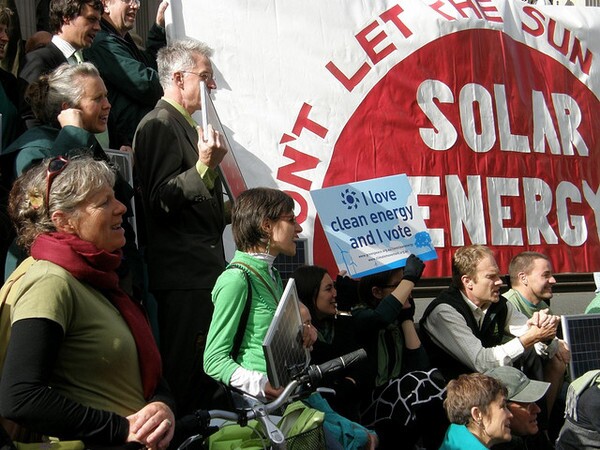Expert: Want To Promote Renewables? Pay People For Power

Australians demonstrate for a better feed-in tariff, 2009 | Photo: Environment Victoria/Flickr/Creative Commons License
A prominent renewable energy analyst said Friday that feed-in tariffs, the wonkily-named practice of having utilities pay a competitive price for all power generated by small renewable installations like homeowners, are the best and fairest way to promote renewable energy development -- more equitable than tax credits, net metering, or renewable portfolio standards. In an essay posted on his website Friday, Paul Gipe, a wind energy expert since 1976, contends that feed-in tariffs are "are more egalitarian than other renewable energy policies."
Related

What Are? PACE Loans, Feed In Tariffs and Net Metering
"They are certainly more egalitarian than the Renewable Portfolio Standards used in North America that restricts renewable energy to multinational corporations," Gipe continues. "Tax credits only benefit those who pay taxes. If the poor don't pay taxes they can't use the tax credits without resorting to complex and costly leasing arrangements that primarily benefit the leasing company.... Net-metering takes customers out of the distribution systems' rate base, leaving the remaining customers to pay for the distribution system."By contrast, says Gipe, well-designed feed-in tariff programs aren't tied to a specific ratepayer meter, meaning that people who can't install solar or wind on their own property -- either because they don't own property or because their property isn't suitable -- can take part in coops and solar garden projects on other sites, reaping returns from the power generated.
"Such projects may use biomass, biogas, wind, or solar," says Gipe. "They are not limited to solar only."
Gipe's essay comes as Washington debates whether to extend the Wind Production Tax Credit, due to expire at the end of December. Most wind industry representatives fear their industry will stagnate if the tax credit, opposed by many Republicans, is allowed to expire. Gipe, who has promoted wind energy on a national level in the U.S. and Canada since 1976, has chosen an interesting time for his criticism of tax credits.
Net metering programs have come under some criticism in recent years for essentially rewarding those property owners most who use the most energy. By limiting power sales to the customer's typical energy use, the people with the greatest incentive to engage in net metering are those who haven't conserved energy or cut their power use effectively. People who've cut their power bills by upgrading their appliances, using efficient lighting, and so forth don't benefit as much by running their electric meters back to zero.
By contrast, feed-in tariffs, by which utilities buy all the surplus energy a renewable energy installation sends to the grid, provide an incentive even for those people with negligible utility bills.
As support for his contention that feed-in tariffs are the fairest incentives for renewables development, Gipe -- unsurprisingly -- cites Germany's example. Two thirds of solar PV in Germany is owned by private individuals, as a result of that nation's enactment of the world's strongest feed-in tariff law.
Gipe, who writes frequently on his website wind-works.org, has promoted and consulted on wind power projects and other renewable energy issues since 1976. He was the executive director of the Kern Wind Energy Association from 1987 to 1995. He was named the American Wind Energy Association's "Man of The Year" in 1988 and ten years later called for that organization to change its focus from renewable portfolio standards and tax credits for wind production to pushing for a feed-in tariff for wind power producers.
That's an impressive set of credentials, suggesting that we might do well to take his advice to heart.
ReWire is dedicated to covering renewable energy in California. Keep in touch by liking us on Facebook, and help shape our editorial direction by taking this quick survey here.


